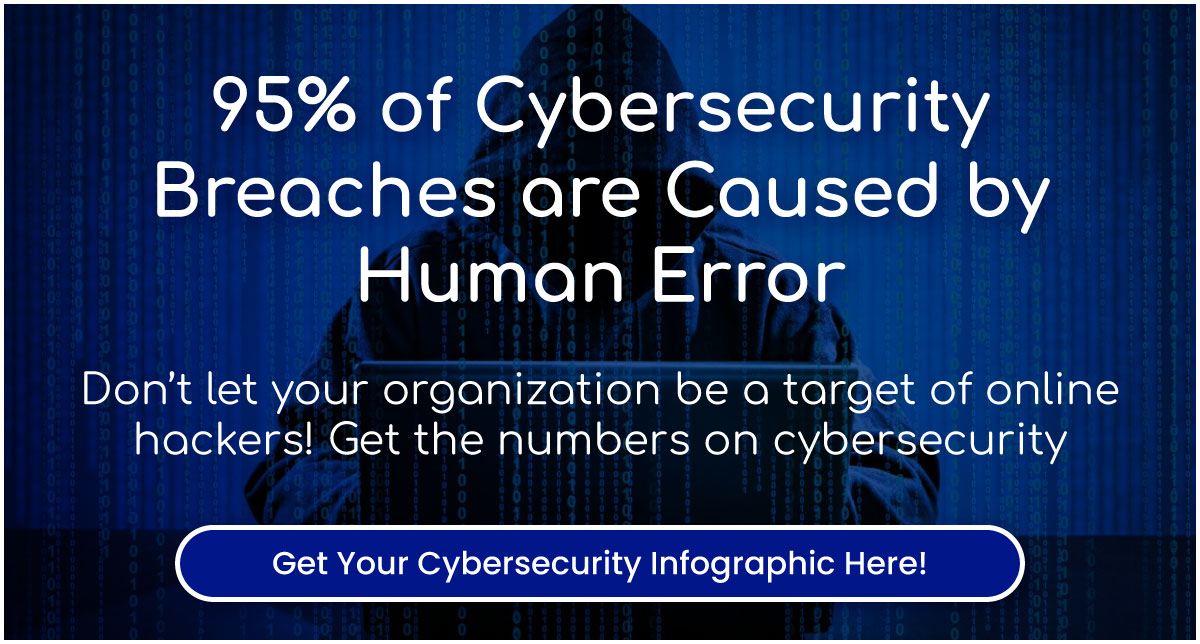Whether you’re a beginner business owner or an experienced entrepreneur, the decision to start your own business is an exciting moment! This is an opportunity to do what you do best, to decide when and how you work, and to form a partnership with someone you know and trust (and maybe an opportunity to get away from people you don’t!).
As you set off on this new journey, you will face challenges. Of this, there is no doubt. Even moments like closing your first sale and bringing in your first check will feel like a milestone in your business’ life. You’ll have legal considerations, the need to balance the books, manage risk, find ways to stand out in crowded marketplaces, and so many more.
But for all the challenges—all of them important—there is one more you shouldn’t overlook.
For many startups and small businesses, cybersecurity is seen as an afterthought. They either don’t think of it or rationalize “I’m too small to be targeted.” In fact, of the businesses with no cybersecurity measures in place, 59% of owners believe this.
And that’s not the only alarming statistic:
%
of small businesses are “not at all concerned” about cyberattacks
%
of businesses with fewer than 50 employees have no cybersecurity budget
%
of small businesses have no cybersecurity measures in place at all
This is a big problem, and it’s only getting worse! There are real consequences for start-ups and small businesses who ignore the threats that exist in cyberspace. For evidence of this, look no further than the steady increase in small businesses who are victims of a cyberattack:
| Year | % Small Businesses Falling Victim to a Cyberattack | % Increase |
| 2021 | 22% | |
| 2022 | 38% | +16% |
| 2023 | 41% | +3% |
*Data compiled by Hiscox; reported by Insurance Business Magazine
This data illustrates the dire need for startups and small businesses to not just be aware of cyber threats, but also to counter them. Business leaders must take charge of just one more part of their new operation.
Don’t be a statistic! 60% of the small businesses that are victims of a cyberattack go out of business within six months. You don’t want to be one of them; and we don’t want you to be either.
So, what can you do?
10 Tips to Protect Your Business
As a cybersecurity firm, and a small business ourselves, we love helping other small businesses succeed! Here are 10 tips every startup can start doing today to secure their future success:
1. Strong Password Policies
When you’re diving into the thrilling world of entrepreneurship, implementing strong password policies might not be the first item on your exhilarating to-do list—but it should be! Here’s how you can strengthen your defenses with just a few keystrokes:
- Use a Password Manager: A password manager allows you to generate and store stronger passwords for every account. This reduces the risk of a password breach and keeps your credentials secure.
- Double Down with MFA: Multi-factor authentication requires not only a password but also another form of verification. This could be a text message confirmation, a biometric scan, or a security token. It adds an essential layer of security.
2. Employee Training
No matter how strong your password policy, your cybersecurity is only as strong as your least informed employee. Regular training sessions can transform your team from a security risk to a sturdy first line of defense:
- Spot the Scam: Educate your employees on recognizing phishing emails and social engineering attacks. Regular updates about the latest scam tactics can keep everyone alert.
- Reinforce with Training Sessions: Conduct regular security awareness training sessions. These sessions should go beyond mere presentations, instead engaging employees with interactive scenarios and quizzes that reinforce good habits.
3. Secure Network Infrastructure
A strong network infrastructure is crucial for safeguarding your startup’s digital assets from cyber threats. Strengthening your networks involves several pivotal steps:
- Fortify Device Security: Set strong, unique passwords for all network devices, including routers and Wi-Fi access points. This straightforward measure can block unauthorized access effectively.
- Update Regularly: Ensure that all network devices and software are frequently updated with the latest security patches. This keeps vulnerabilities to a minimum.
- Set Up Your Firewall: A firewall serves as a barrier between your internal network and incoming threats from the internet. Make sure it’s properly configured to protect your network without hindering operational needs.
4. Data Encryption
Encrypting your data is like placing your most valuable information in a vault. It’s essential for protecting sensitive data whether it’s stored on your systems or transmitted over the internet:
- Encrypt at All Stages: Ensure that all sensitive data is encrypted both at rest and in transit. This protects it from unauthorized access no matter where it is stored or how it is sent.
- Use Strong Protocols: Adopt strong encryption algorithms and secure key management practices to effectively safeguard your data against emerging threats.

Encryption acts as a lock to make your data indecipherable to cybercriminals.
5. Regular Security Audits and Penetration Testing
The threat landscape is constantly evolving. It makes cybersecurity sometimes feel like a game of cat and mouse between businesses and cybercriminals. Do not play this game. Take control! Your strategy should include:
- Security Audits: Regularly conduct these to map out the ever-evolving threats and keep your defenses updated.
- Expert Insights: A proficient cybersecurity expert brings a wealth of knowledge, transforming your strategies from guesswork to precision. They can provide services such as penetration testing. Also known as “pen testing,” penetration tests simulate a real cyberattack, so you can know what weaknesses exist in your network.
6. Incident Response Plan
Imagine a security breach as a fire alarm. You need an escape plan that’s second nature to everyone within the building. That’s your Incident Response Plan—a clear, actionable strategy to control and extinguish unexpected fires in your digital infrastructure:
- Comprehensive Planning: Develop an incident response plan that’s tailored to your business, leaving no stone unturned and ensuring you’re ready for any contingency.
- Regular Drills: Practice makes perfect. Regularly exercising your incident response plan is crucial to ensuring effectiveness. So, should an actual breach occur, your team will know how to respond.

It’s critical to prepare for the worst. So, have a response plan in place and train your employees.
7. Third-Party Risk Management
In today’s interconnected business ecosystem, your security is also reliant upon third-party vendors and service providers. If they get hacked, your data is also at risk. To mitigate this, be sure to follow these steps:
- Vigorous Vetting: Make sure every third-party partner has security standards that meet your expectations. That goes beyond due diligence, it is also a necessity. It’s about having confidence in their ability to protect the data and systems they access or manage for you.
- Ongoing Assessments: The digital landscape and business relationships also evolve over time. So, continually reassess your partnerships. A once-secure vendor could become a future vulnerability.
8. Data Backup and Recovery
In the event of cyberattacks, system failures, or disasters, the difference between a minor setback and a major catastrophe often depends on your preparedness to restore what’s lost:
- Robust Strategy: Implementing a thorough data backup and recovery strategy means defining what data gets backed up, how often, and the mechanisms for recovery. This strategy acts as a safety net, capable of catching your business should an unforeseen event threaten your data’s integrity.
- Routine Testing: Backup is only as reliable as its last successful restore test. Regularly testing these procedures ensures your safety net isn’t just there but also strong enough to hold under the worst circumstances.
Many service providers mention disaster recovery solutions, which typically encompass comprehensive data backup systems. Make sure your provider offers a solution that aligns with your recovery objectives.
9. Compliance with Regulations
When it comes to data protection, staying ahead means staying informed. Compliance is a legal duty, yes, but it’s also a marker of your young organization’s integrity and commitment to protecting your customers’ data.
- Stay Updated: Across different geographies, regulations like the General Data Protection Regulation (GDPR) and the California Consumer Privacy Act (CCPA) set the benchmark. Staying aware of these regulations ensures that your practices are not only compliant but also demonstrate to customers and stakeholders your dedication to data privacy.
- Implementation as Standard Practice: Regularly review and adjust your data handling and storage practices to align with the latest legal requirements. This proactive approach helps to avoid potential fines and builds trust with users who are increasingly aware of data privacy issues.

A business lawyer will help you understand the rules and regulations relating to your customer’s data.
10. Security Culture
A strong security culture is the backbone of any resilient organization, turning each employee into a guardian of your digital assets.
- Cultural Build-Up: Encourage a workplace ethos where security is everyone’s business. By fostering this mindset, you turn every staff member into an active participant in safeguarding the company.
- Open Reporting Channels: Make it easy and safe for employees to report anomalies. Establishing clear, simple procedures for reporting suspicious activities ensures that potential threats are dealt with swiftly and efficiently.
Regular training and updates can help keep security top of mind. Use engaging methods like workshops, simulations, and games to teach and reinforce security principles among your teams.
Secure Your Startup with Innovative Integration
As you stand on the brink of a new and exhilarating chapter in your entrepreneurial journey, we hope you see a bright future, full of possibilities.
When you are looking for technological empowerment, Innovative Integration will walk beside you. Together, we can build a resilient, secure foundation for your business to thrive.
Start your journey today—contact Innovative Integration and let us help you secure your new business’ future!






